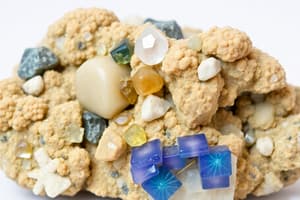Podcast
Questions and Answers
What type of luster does galena exhibit?
What type of luster does galena exhibit?
- Metallic luster (correct)
- Resinous luster
- Earthy luster
- Vitreous luster
What percentage of all minerals are silicate minerals?
What percentage of all minerals are silicate minerals?
- 90% (correct)
- 70%
- 50%
- 80%
What type of rocks are formed through the process of crystallization?
What type of rocks are formed through the process of crystallization?
- Hydrothermal rocks
- Metamorphic rocks
- Sedimentary rocks
- Igneous rocks (correct)
What is the primary source of paleo-environmental information?
What is the primary source of paleo-environmental information?
What is the term for the process of breaking down rocks into sediments?
What is the term for the process of breaking down rocks into sediments?
What type of rocks are characterized by a high degree of magma differentiation?
What type of rocks are characterized by a high degree of magma differentiation?
What is the term for the process of transforming sediment into sedimentary rock?
What is the term for the process of transforming sediment into sedimentary rock?
What is the primary purpose of prospectors in the mining industry?
What is the primary purpose of prospectors in the mining industry?
What is the term for the cracks in rocks that have been filled with minerals?
What is the term for the cracks in rocks that have been filled with minerals?
What is the approximate amount of minerals and metals needed for green energy production?
What is the approximate amount of minerals and metals needed for green energy production?
What is the study of crystal shapes called?
What is the study of crystal shapes called?
Which of the following is not a reliable method to identify minerals?
Which of the following is not a reliable method to identify minerals?
What determines the properties of a mineral?
What determines the properties of a mineral?
Which is referred to as the mineral capital of Canada?
Which is referred to as the mineral capital of Canada?
What is the way light is reflected called in relation to minerals?
What is the way light is reflected called in relation to minerals?
Flashcards
Galena
Galena
A mineral with a metallic luster often used in lead production.
Vitreous luster
Vitreous luster
A type of luster that reflects light like glass.
Mohs Hardness Scale
Mohs Hardness Scale
A scale that measures mineral hardness based on scratchability.
Silicate minerals
Silicate minerals
Signup and view all the flashcards
Non-silicate minerals
Non-silicate minerals
Signup and view all the flashcards
Ores
Ores
Signup and view all the flashcards
Mine life cycle
Mine life cycle
Signup and view all the flashcards
Partial melting
Partial melting
Signup and view all the flashcards
Igneous rocks
Igneous rocks
Signup and view all the flashcards
Sedimentary rocks
Sedimentary rocks
Signup and view all the flashcards
Weathering
Weathering
Signup and view all the flashcards
Lithification
Lithification
Signup and view all the flashcards
Crystallization
Crystallization
Signup and view all the flashcards
Mineral identification
Mineral identification
Signup and view all the flashcards
Luster
Luster
Signup and view all the flashcards
Study Notes
Mineral Properties
- Galena has a metallic luster
- Vitreous luster reflects white light like glass
- Hardness is measured by scratchability using the Mohs Hardness Scale
- The Vickers penetrometer measures hardness quantitatively
Mineral Groups
- Silicate minerals are the most important mineral group, accounting for 90% of all minerals
- Non-silicate minerals include carbonates, evaporites, and metallic minerals
- Examples of silicate minerals include quartz, feldspar, and biotite
- Examples of non-silicate minerals include calcite, dolomite, halite, magnetite, hematite, galena, and sphalerite
Mineral Resources
- Ores are concentrations of minerals that are the foundation of the mineral resource industry
- The life cycle of a mine involves exploration, discovery, development, production, and reclamation
- Prospectors are involved in the exploration for mineral resources
- 3 billion tons of minerals and metals are needed for green energy production
Rock Formation
- Rocks only partially melt, resulting in different minerals with different melting points
- Partial melting leads to a difference in composition between the magma and the original rock
- Crystallization occurs when magma cools and solidifies, forming a new solid rock
- Minerals crystallize at different temperatures, with mafic minerals (low silica) crystallizing at higher temperatures than felsic minerals (high silica)
Types of Rocks
- Igneous rocks are formed through the cooling and solidification of magma
- Examples of igneous rocks include granite, basalt, and pegmatites
- Sedimentary rocks are formed through the breakdown of surface rocks and the accumulation of sediments
- Examples of sedimentary rocks include sandstone, shale, and conglomerate
Weathering and Sedimentation
- Weathering is the breakdown of rock into sediments through exposure to the elements
- Mechanical breakdown produces clasts, while chemical breakdown produces finer grains
- Lithification is the process of turning sediment into sedimentary rock
- Sedimentary rocks are the biggest source of paleo environmental information, including climate and life change and fossils
Mineral Identification
- Minerals have a prescribed composition that determines their properties
- There are over 4000 minerals identified, with each having unique properties
- Bancroft is known as the mineral capital of Canada
- Minerals can be identified through color, streak, crystallography, and cleavage
- Luster is the way light is reflected, and can be used to identify minerals
Studying That Suits You
Use AI to generate personalized quizzes and flashcards to suit your learning preferences.




